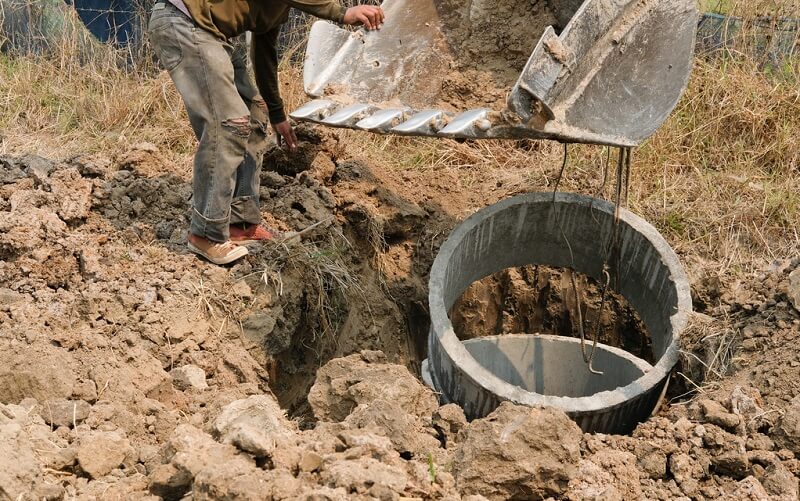Check the Leach Field for Clogs
by Admin
Posted on 09-08-2023 11:18 AM

Before you can begin any sort of landscaping, it’s critical to know exactly where all the components of your septic system are. If you just had the system installed, your contractor should have left you with an as-built, which is a drawing of exactly where all the components are. If you moved into a home with an existing septic tank, you may need to check with your local public health department if the previous owner didn’t leave it for you. Once you have the drawing, locate the leach field, septic tank and pipes on your property.
 Over these areas, you should not have any:.
Over these areas, you should not have any:.
Always vent the ends of each chamber run to ensure healthy air flow through system. Inspection port at end of each run must be drilled with holes to provide venting. Air is pulled through the chambers and out the plumbing vent atop roof of house. Fresh air and healthy soil are critical for long-term viability of leach fields. Standard ventilation specification is 1/8" diameter holes drilled at least one every square inch for at least eight inches above finish grade and capped. Larger holes are discouraged to prevent insects from nesting in the vent port. By allowing air to draft through chambers, you provide oxygen to an otherwise sealed cavity.
What Is a Leach Field?
These days your average home has a garbage disposal in the sink, regardless of whether it has a septic system or not. A garbage disposal is one of the worst things you can do to a septic system. It is the septic equivalent of putting sugar in someone’s gas tank.
 Okay, maybe it is not that bad, but a garbage disposal is not good for a septic system at all. The food that will be introduced into your septic tank will not break down like the solids that are normally introduced and can lead to clogging of the leach field and overflow.
Okay, maybe it is not that bad, but a garbage disposal is not good for a septic system at all. The food that will be introduced into your septic tank will not break down like the solids that are normally introduced and can lead to clogging of the leach field and overflow.
Though it may not be a particularly appealing chore, performing regular maintenance on a home septic system is unavoidable for the roughly 60 million americans served by this type of waste-handling scenario. Septic systems that function as intended can safeguard the surrounding environment by eliminating pollutants from surface waters. This renders large treatment plants unnecessary in many areas of the country. However, when septic systems go without essential maintenance, the consequence can be nasty. The septic system’s design is relatively straightforward: it comprises a tank that sends material to a drain (leach) field. The intent is that solids and liquid waste will undergo decomposition processes within the tank and ultimately flow to the drain field.
Remember while your septic system is underground, heavy equipment can cause damage. Do not drive anything heavier than a lawn mower over your leachfield/drainfield. It is also not a good idea to drive over the pipes leading to and from your septic system.
by ri industries ri industries your septic tank may not always be top of mind when you’re considering home maintenance, but it’s an important part of your home and something not to be overlooked. Properly caring for your septic tank will extend its life and value, while helping to keep septic tank costs down. Follow these nine easy steps to septic tank care, and you’ll help maintain your septic tank even longer: septic tank care tip #1: don’t throw rubbish down your toilet. It’s so tempting to flush rubbish down your toilet, but it’s very unhealthy for your septic tank system.
Let’s talk more about your septic tank’s ecosystem. To function properly, a septic tank relies on a bacterial colony to process waste. However, you can bolster that colony with—of all things—rotten tomatoes. If you’ve had some tomatoes in the fridge that never made their way into a salad or pasta sauce, don’t lob them at a bad comedian! grind them up as healthy reinforcements for your septic system, where their enzymes will fortify your system’s ability to break down solids. That’s no joke.
Bacteria are what makes a septic system work. They break down waste, leaving water clean enough to safely percolate down into the earth. The whole system is designed to keep bacteria healthy and busy. Some live in the tank, but most do their work in the drain field. 1. All waste flows to the septic tank. 2. Watery waste, called “effluent,” fills most of the tank. Anaerobic bacteria begin breaking down the organic material in the effluent. 3. A layer of sludge falls to the bottom. Sludge is composed of inorganic solids and the byproducts of bacterial digestion. 4.